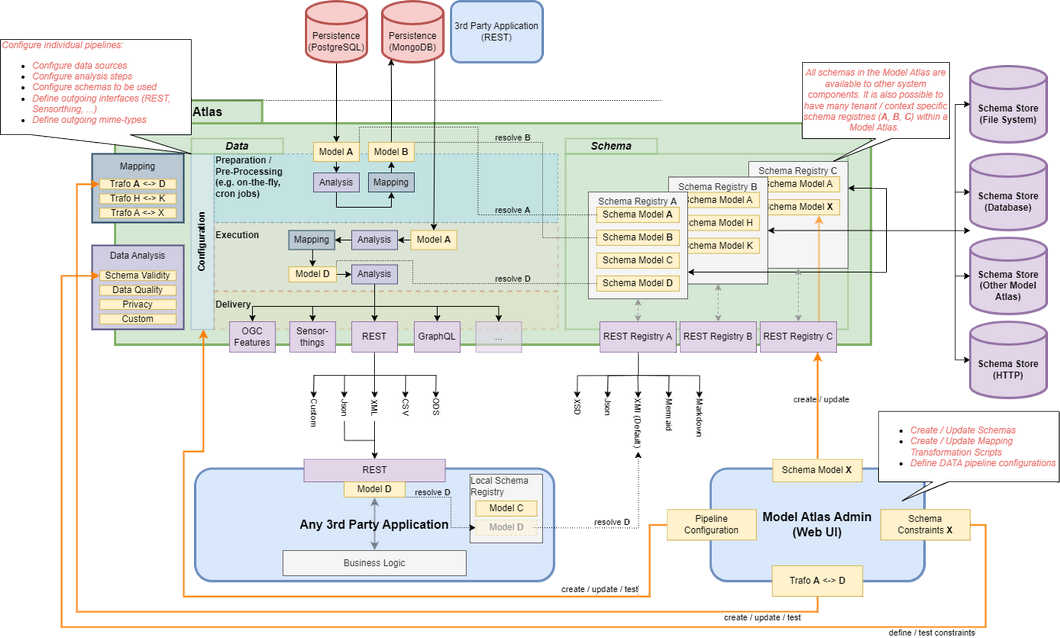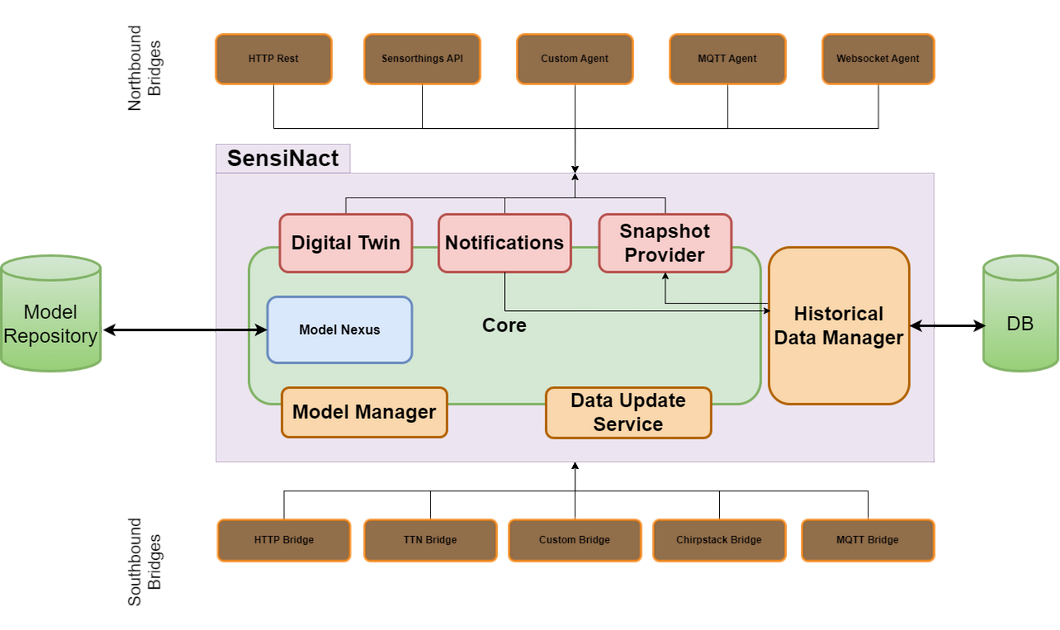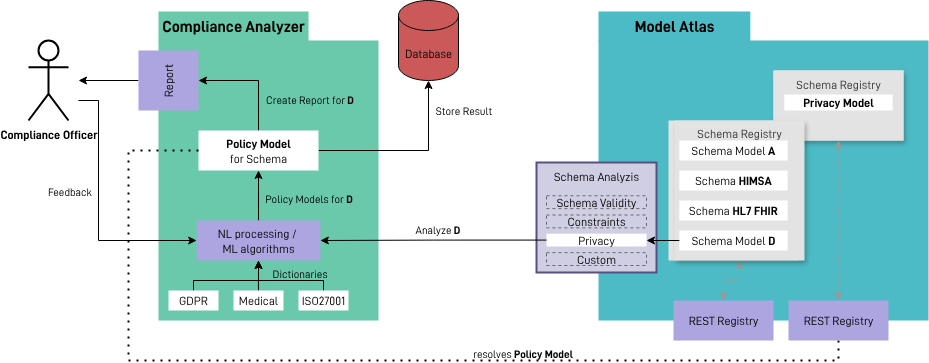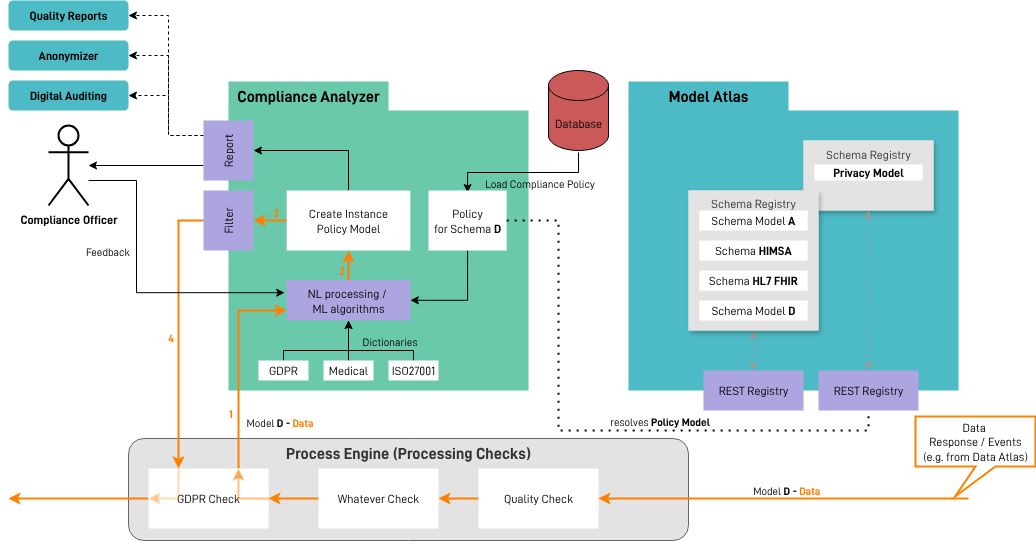Next Level Data Governance
An effective governance strategy requires a strong technological foundation. Our Data Governance Platform is designed from ground level upwards to handle the complex requirements of modern data governance, compliance, risk management and stakeholder reporting. Its modular, expandable open-source architecture enables you to regain control and sovereignty over your entire digital ecosystem.
The architecture of our platform is built on three core principles:
1. Define: The Model Atlas as a “Single Point of Truth”
Every form of control begins with a clear definition. Our Model Atlas is the central semantic layer of your governance. Here, not only technical data models but also business rules, security policies, and compliance requirements are stored as formal models, creating a unified, machine-readable source of truth.
2. Integrate: Non-Invasive Control Through Adapters
Governance must not stifle innovation. Instead of replacing existing systems, our platform integrates non-invasively into your IT landscape via a flexible Adapter Layer, ensuring that the rules defined in the Model Atlas are applied and enforced throughout the organization.
3. Analyze & Prove: Tools for Trust and Transparency
Compliance must be verifiable. Our platform offers specialized tools for this purpose, including a powerful Policy & Governance Engine for automated checks and a Digital Notary for creating a tamper-proof audit trail of all governance-relevant events.
Our Technology, Expertise & Open Source Foundation
Our platform is built on proven, powerful open-source technologies and model-driven principles. This deep expertise enabled us to create a powerful product and is also available to you as a specialized technical consulting service:
- Model-Driven Engineering (MDE): At our core, we leverage model-driven software development with technologies like the Eclipse Modeling Framework (EMF) and UML. We offer specialized consulting to help your teams design and build robust, scalable software architectures based on these principles.
- Modular Architecture with OSGi: All our components are developed based on OSGi, guaranteeing a highly modular and dynamic system. As active members of the OSGi Alliance Working Groups, we don’t just use this standard - we help shape its future. We pass this cutting-edge knowledge on to you through targeted technical consulting and training.
Open Source Commitment: We believe in the power of open collaboration. All components of our platform are open source.
- Current Repository: https://github.com/geckoprojects-org
- Future Eclipse Project: Eclipse Fennec (GitHub)
Technological Core Component Deep Dive
Model Atlas
Our Model Atlas Technology provides a universal, modular, and expandable framework for data management. At its core is a powerful set of tools for model creation and ingestion. We utilize AI to generate models from various input formats, read models directly from SQL schema descriptions, and import from standards like JSON-Schema, XSD, and OpenAPI. This flexibility makes it a key enabler for connecting data from various sources with distributed applications.
Shining key features include:
- Web-based EMF Model Registry & Multi-Tenancy
- Extendable governance analysis and validation
- Pluggable model output formats (XMI, XSD, Json-schematics)
- Automatic documentation generation (PlantUML, ODS, etc.)
- DCAT / RDF Support for Open Data or Dataspace registries
- Client adapter for model discovery (EMF Java, TypeScript, Python)
The Adapter Layer
The Model Atlas can be integrated in almost every distributed software architecture. Our extensive library of adapters and codecs ensures seamless connectivity with your existing landscape. This includes native support for:
- Databases: Relational Databases (via JDBC), MongoDB
- Messaging & Streaming: Apache Kafka, Apache Camel
- Storage & Search: S3/Minio, Apache Lucene
- APIs: Deep integration for REST with Jakarta RESTful Web Services (we are currently working on a generic OpenAPI client)
- IoT: Deep integration into the sensiNact IoT Broker
- Transformation & Serialization: Powerful transformation adapters (QVT) and a highly adaptable codec based on Jackson for numerous serialization formats

SensiNact: IoT Integration Broker
SensiNact is an IoT-Broker designed to integrate heterogeneous IoT-Devices. It normalizes device access, data, and metadata into a common information model. The platform allows for the creation of smart applications that can easily manage and interact with a wide range of IoT devices, regardless of their underlying technology. We are active committers in this open-source project and offer consulting and development services for the sensiNact platform, including creating custom device adapters.
Shining key features include:
- Connectivity: SensiNact is well equipped to deal with the broad heterogenity of today’s IoT landscapes. Built in protocols support LoRa, Zigbee, IEEE 802.15.4, Sigfox, enOcean, MQTT, XMPP, NGSI, HTTP, CoAP and many more. Thanks to its modularity, support for new protocols can be rapidly developed and dynamically added, even at run-time.
- Data and Event Processing: The distributed approach keeps data processing as close as possible to the source trhough all data layers. It offers basic processing functionality like filtering as well as advanced aggregation functions on streaming data. New functions can be added via extension points.
- Plug & play-readiness: Thanks to the service-oriented approach, new data sources can be added, removed, or updated in a flexible manner with minimum impact on the running platform.
- Interoperability: SensiNact adpots a generic and extensible data model to facilitate building adapters for various protocols.
- Modularity: Modular deployment and development allow for enhanced maintenance and evolution of live systems.
- Dependable: Formal data and service models allow for facilitating reliable IoT applications development. Thus the broker can be adapted to most standards or niche models in the IoT sphere.
- Scalable: The architecture contains three main layers, allowing distribution of data processing regardless of the level. It is applicable on devices, on gateway levels and even on cloud levels.
- Easy & quick: Thanks to the comprehensive data models and APIs, sensiNact provides a very accessible solution for the growth of IoT applications.

Policy & Governance Engine (former MPAT)
At the core of our analysis capabilities is a powerful governance engine. Its origins lie in our Model-Driven Privacy Analyzing Tool (MPAT), but it has evolved into a versatile solution for enforcing a wide range of policies.
The engine operates at both the model level (design-time analysis of schemas) and the instance level (run-time analysis of actual data). Its rules are not hard-coded; they are defined in adaptable “Policy Packs” (e.g. for GDPR, ISO 27001, EU AI Act, Cyber Resilience Act, ESG Reporting Frameworks), allowing for customized and extensible governance. Furthermore, the engine can validate policies against the declared capabilities of your infrastructure components (assets), ensuring that technical reality aligns with regulatory requirements.

Check process on model level (analyzing the schema design)

Check process on instance level (analyzing the actual data)
Digital Notary
The Digital Notary is a key component for creating verifiable trust in digital processes. Based on blockchain technology, it provides a tamper-proof, immutable log of all governance-related events. Every significant action - from approval of a data model by a Data Steward to the result of an automated compliance check - is cryptographically sealed and chained. This creates a complete and trustworthy audit trail that can be presented to auditors or regulators at any time, providing conclusive proof that all defined processes and policies have been adhered to.
Data Integration Services
Our technology allows application in various use cases, where data integration and governance are required. With its functionality, we can create scalable solutions in different data environments by applying all or - to keep your IT infrastructure as sleek as possible - selected components for your data environment.
Urban Data and Smart City Platforms
Urban data platforms are at the heart of modern smart city infrastructures. As data hubs, they provide internal and external stakeholders with the data they need for their work or interests. Additionally, they enable comprehensive data queries in terms of data transparency, enable clear processing of data queries via dashboards and can thus become powerful tools for internal data management and increasing efficiency in entire process chains.
We create a modular, expandable and open-source proven architecture to integrate various use cases in smart city environments. With a service-oriented data hub, our data broker controls the collection and distribution of all integrated data, while the model atlas ensures the interoperability of a wide variety of data structures. Thanks to the modular and expandable structure, additional services (DCAT registry, document service, etc.) can be connected depending on the requirements or complexity level and scaled to the depth of the mapped data structures.
The result is a flexible smart city solution that is easy to maintain and - if desired - can be fully managed by the end user. It can be used independently of any system, does not create any additional dependencies, ensures maximum interoperability and prevents the creation of data silos through stringent modeling. Use case applications encompass a wide variety from the integration of sensor data or data bases to data hubs for whole process chain environments.
Selected Use Case Examples
Environmental Sensor Data Integration + Model UI
We provide a ready to deploy setup for integration, management and an end user friendly analyzing dashboard that is capable of visualizing sensor data in an highly customizable no-code interface. The showcase example demonstrates the customization experience on the dashboard with several soil moisture sensors, which can be added and integrated via plug&play.
Smart Traffic Data System
With our Traffic Signal Detection System, we provide a solution to connect traffic light systems into smart city infrastructures. By using an easy-to-maintain hardware setup, we make traffic light phases and sensor inputs readable and transferable in real time. This solution enables municipal operators to access monolithic traffic light systems, which are often equipped with proprietary software. The collected real time traffic data can be used to implement smart switching systems into existing infrastructure without having to procure new traffic control technology (e.g. making it SUMO ready). By pairing this data with streams from other data sources like traffic cameras, we offer a comprehensive data suite for facilitating real time traffic monitoring or enabling smart traffic control solutions, with nearly endless use case combination possibilities.
Traffic Conflict Detection
Our technology is successfully used to manage complex real-time scenarios. By combining data from various sources (sensors, signal systems), we can predict potential conflicts in road traffic in real-time - a use case that requires highest standards of real-time data quality, security, and traceability.